
The Orchidaceae are a diverse and widespread family of flowering plants, with blooms that are often colourful and fragrant, commonly known as the orchid family.
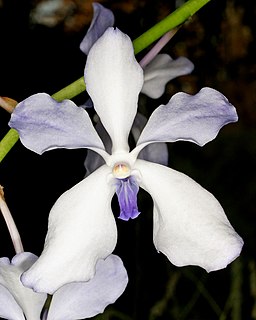
Vanda, abbreviated in the horticultural trade as V., is a genus in the orchid family, Orchidaceae. There are about 80 species, and the genus is commonly cultivated for the marketplace. This genus and its allies are considered to be among the most specifically adapted of all orchids within the Orchidaceae. The genus is highly prized in horticulture for its showy, fragrant, long-lasting, and intensely colorful flowers. Vanda species are widespread across East Asia, Southeast Asia, and New Guinea, with a few species extending into Queensland and some of the islands of the western Pacific.
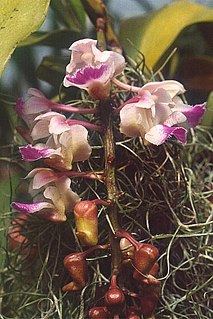
Aerides, known commonly as cat's-tail orchids and fox brush orchids, is a genus belonging to the orchid family. It is a group of tropical epiphyte orchids that grow mainly in the warm lowlands of tropical Asia from India to southern China to New Guinea. They are valued in horticulture for their racemes of showy, fragrant, colorful flowers.
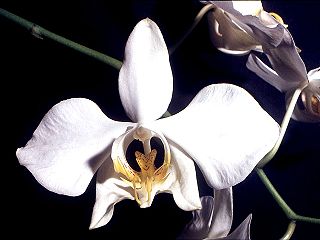
PhalaenopsisBlume (1825), commonly known as moth orchids, is a genus of about seventy species of plants in the family Orchidaceae. Orchids in this genus are monopodial epiphytes or lithophytes with long, coarse roots, short, leafy stems and long-lasting, flat flowers arranged in a flowering stem that often branches near the end. Orchids in this genus are native to India, Taiwan, China, Southeast Asia, New Guinea and Australia with the majority in Indonesia and the Philippines.

The Pontifical and Royal University of Santo Tomas, the Catholic University of the Philippines, or simply the University of Santo Tomas (UST), is a private, Catholic research university in Manila, Philippines. Founded on April 28, 1611, by Spanish friar Miguel de Benavides, Archbishop of Manila, it has the oldest extant university charter in the Philippines and in Asia, and is one of the world's largest Catholic universities in terms of enrollment found on one campus. The university is run by the Order of Preachers. UST is the only university to have been visited by three popes four times: once by Pope Paul VI on November 28, 1970, twice by Pope John Paul II on February 18, 1981, and January 13, 1995, and once by Pope Francis on January 18, 2015. The patron of the university is St. Thomas Aquinas, while St. Catherine of Alexandria is the patroness.

Thomas Lobb (1817–1894) was a British botanist and, along with his older brother, William Lobb, collected plants for the plant nursery Veitch.

Vanda luzonica is a species of vanda, a flower of the orchid family. It is a rare type of orchid and is endangered. Vanda luzonica is named after the island of Luzon in the Philippines.

Vanda scandens is a species of plant in the family Orchidaceae. It is endemic to Mindanao island and Palawan Island in the Philippines.
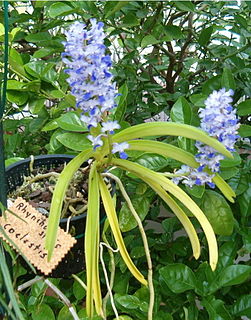
Rhynchostylis is a genus in the orchid family (Orchidaceae), closely allied to the genus Vanda and comprising four currently accepted species native to the Indian Subcontinent, China, Indochina, Malaysia, Indonesia and the Philippines. The name consists of a compound of two Greek elements : rhynchos 'beak' and stylis 'column' – in reference to the very broad, fleshy column of the flower. The flowers are borne in dense racemes and are noted for their intense, spicy fragrance. Although lacking in pseudobulbs, the plants have leathery leaves that are drought-resistant. These orchids grow naturally in warm, moist, shaded tropical areas and will thrive in cultivation if given consistent warmth, uniform moisture and bright, but indirect light. Hobbyists wanting to grow them will need a warm, humid growing environment with gentle air movement. They can be grown in pots, but are better grown in baskets, owing to the extreme fleshiness of their roots. Their unusually fragrant blooms often appear in the slightly cooler winter months.
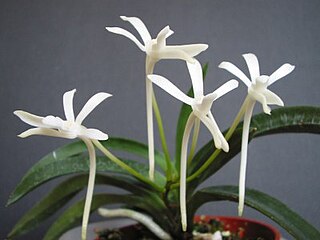
Neofinetia was a genus of flowering plants from the orchid family, Orchidaceae but is now classified as a Vanda. Three species are found in China, two species are found in Korea, and one species is found in Japan.
Arturo B. Rotor was a Filipino medical doctor, civil servant, musician, and writer.

Rhynchostylis gigantea is a species of orchid. This species was first described in 1896 by John Lindley and occurs in Myanmar, Thailand, Malaysia, Laos, Cambodia, Vietnam, Hainan China, Borneo, Bangladesh, Northeast India and the Philippines.

The University of Santo Tomas is one of the oldest existing universities and holds the oldest extant university charter in the Philippines and in Asia. It was founded on April 28, 1611 by the third Archbishop of Manila, Miguel de Benavides, together with Frs. Domingo de Nieva and Bernardo de Santa Catalina. It was originally conceived as a school to prepare young men for the priesthood. Located Intramuros, it was first called Colegio de Nuestra Señora del Santísimo Rosario and later renamed Colegio de Santo Tomás in memory of Dominican theologian Saint Thomas Aquinas. In 1624, the Colegio was authorized to confer academic degrees in Theology, Philosophy and Arts. On November 20, 1645 Pope Innocent X elevated the College to the rank of a university and in 1680 it was placed under royal patronage.

Vanda limbata is a species of orchid native to Java, the Lesser Sunda Islands and the Philippines.

Vanda sanderiana is a flower of the orchid family. It is commonly called Waling-waling in the Philippines and is also called Sander's Vanda, after Henry Frederick Conrad Sander, a noted orchidologist. The orchid is considered to be the "Queen of Philippine flowers" and is worshiped as a diwata by the indigenous Bagobo people.

Papilionanthe Miss Joaquim, also known as Vanda Miss Joaquim, the Singapore orchid, or the Princess Aloha orchid, is a hybrid orchid that is the national flower of Singapore. For its resilience and year-round blooming quality, it was chosen on 15 April 1981 to represent Singapore's uniqueness and hybrid culture.
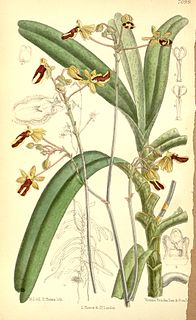
Cottonia is a monotypic genus of flowering plants from the orchid family, Orchidaceae: the only known species is Cottonia peduncularis. It is native to India and Sri Lanka. The genus was erected by Robert Wight and named after Major F. Cotton, an amateur botanist who served in the Madras Engineer Group and collected the species from Tellichery.
"Blue Orchid" is a song by the White Stripes.

Vanda roeblingiana, Roebelen's vanda, is a species of orchid endemic to the mountain provinces of the island of Luzon in the Philippines. Hugh Low, a British colonial administrator and naturalist introduced the plant to London in 1893. The next year, Robert Allen Rolfe, an English botanist formally described the plant and thought it was originally collected from the vicinity of Singapore or Peninsular Malaysia. Low, who works in Clapton Nursery had collecting expedition to Southeast Asia with Singapore as headquarter.

















